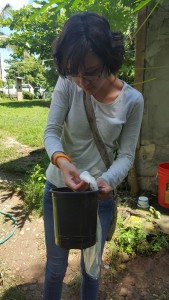Originally published October 4, 2016
By Vanessa Enriquez
Doctoral student, Biological Sciences
I greeted Buenas to everyone we encountered while searching the village of Darien, Panama for placed ovitraps (mosquito egg collection tools). It had only been my partner’s and my first week in Panama when our mentor told us we would be doing field work in Darien.

Ending up there began six months prior, when I first applied to UTEP’s Minority Health International Research Training (MHIRT) program. I applied to the program not knowing what my research topic would be or where I would end up, but sure that I would have the opportunity to make an impact on minority health disparities through international research. For that reason, I was grateful to be a part of the program from the start.
Around March or April, I found out that I would be working on trying to identify the malaria vector mosquitoes with Dr. Loaiza from INDICASAT-AIP in Panama, namely the Anopheles species, using a mass spectrometry method called MALDI-TOF. MALDI-TOF stands for mass-assisted laser desorption ionization-time of flight, which is an analytical technique used to obtain spectra of masses in a sample. In our case, the masses in the spectra would represent proteins in the mosquito that were ionized by the help of a laser.

Photo courtesy of Vanessa Enriquez
However, my partner, Elia, and I soon found out that our seven-week research project had been changed due to the Panamanian emergence of local transmission of the Zika virus. Our project objective was to develop a MALDI protocol to identify the Aedes aegypti or Aedes albopictus mosquitoes, the species responsible for transmitting the Zika virus. This research was important to Panama since the presence of the Panama Canal allows for the exchange of many tourists and goods. It also relates to our borderland since Aedes aegypti is present in the Paso del Norte region, where there is also an exchange of people and goods at the border.
Presently, the methods used to identify mosquito eggs are costly, time-consuming and require experienced personnel. The preliminary work of MALDI shows promise for more efficient vector surveillance and vector control because it is faster, cheaper and does not require experienced personnel. If MALDI can be successfully used to identify mosquito eggs, the risk of infection for an area can be calculated and outbreaks can be prevented. It would save time and resources when people’s lives are at risk, such as with Zika, thus helping to close the gap in minority health with respect to mosquito vector diseases.
On the weekends, the program would schedule international experiences in Panama. Through this, we got a deeper appreciation for different aspects of the Panamanian culture. On one tour, we spent the day with one of Panama’s surviving indigenous communities where we got to learn about their music, food, clothes and history.